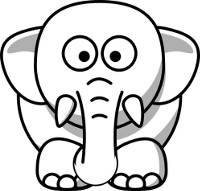In order to comprehend the origins of the White Elephant Exchange it's important to firstly delve into the history and the tradition that encompasses it.
If you want to know how to play the game, have a look at the white elephant rules and also check out the white elephant gifts because you will need one for the party.
It maybe surprising to some to learn that earlier on in history people would actually give white elephants as gifts for a White Elephant Gift Exchange. This explains where the tradition today of exchanging insignificant and unwanted gifts got its name from.

Roots Of White Elephant Tradition
Looking back, it's very evident that a person in North America was very unlikely to have in their possession a white elephant. In other parts of the world though, it was common for rulers in parts of Asia to have white elephants under their control.
Throughout time, regardless of the location in the world, leaders have had interest in uncommon items. Some of these goods were rare jewelry and unique animals that possessed a special trait that mad them sought after by those rulers.
It was a common practice for rulers of other kingdoms to give gifts of rare animals to other kings. The purpose of giving such unique gifts was to demonstrate an interest in forging bonds and, in other cases, to mend ties that had been broken. Surely, such an unusual gift would win over its recipient and a healthy relationship would flourish.
White elephants were admired in the previously known kingdom of Siam, now Thailand. Having a white elephant in your possession meant that you were powerful and highly regarded amongst the people. Therefore, white elephants were meant for kings and their family.
Kings would sometimes use white elephants as a type of punishment gift to give those who displeased them. Giving a white elephant to someone other than a king was more of a curse because of the expense and care that was required, it was a burden. The noble dare not get rid of the white elephant, as this would be insulting towards their king and harsh consequences would be in store for them.
Here we can see where the legend of the white elephant emerged and that our White Elephant Exchange today actually materialized from past events and tradition.
Where Does The Name Come From?
"White Elephant" comes from the phrase "Chang Samkhan", which in the Thai language is not in relation to color, but rather its attractiveness. "Purity" is the direct translation, thus exemplifying why these animals were only fit for kings.Modern Evolution Of White Elephant Christmas Game
The white elephant didn't emerge into the western world until the late 19th century, in England and the USA didn't see them popping up there until the beginning of the 20th century.
According to a popular authors recount of the first white elephant in England, its name was Toung-Taloung and with the creature came an orchestra and a priest. People long awaited the first white elephant, but were disappointed to learn that the animal was pinkish in color and not white. Toung-Taloung was on display at the Royal Zoological Gardens in London, but because people took little interest the elephant was then shipped to the USA. Not surprisingly, people there were also disinterested when they met Toung-Taloung.
This white elephant was nothing but a burden and that's when the term White Elephant exchange emerged. During the late 19th century to early 20th century you'd come across White Elephant Exchanges, where people would get rid of their unwanted items. People found these White Elephant Exchanges to be great fun, so it's of no surprise that they're so popular today.
The White Elephant Gift Exchange, that was once a small tradition off the streets of New York, has emerged into a mammoth Christmas custom. It is enjoyed amongst family, friends and work colleagues all over the world.






